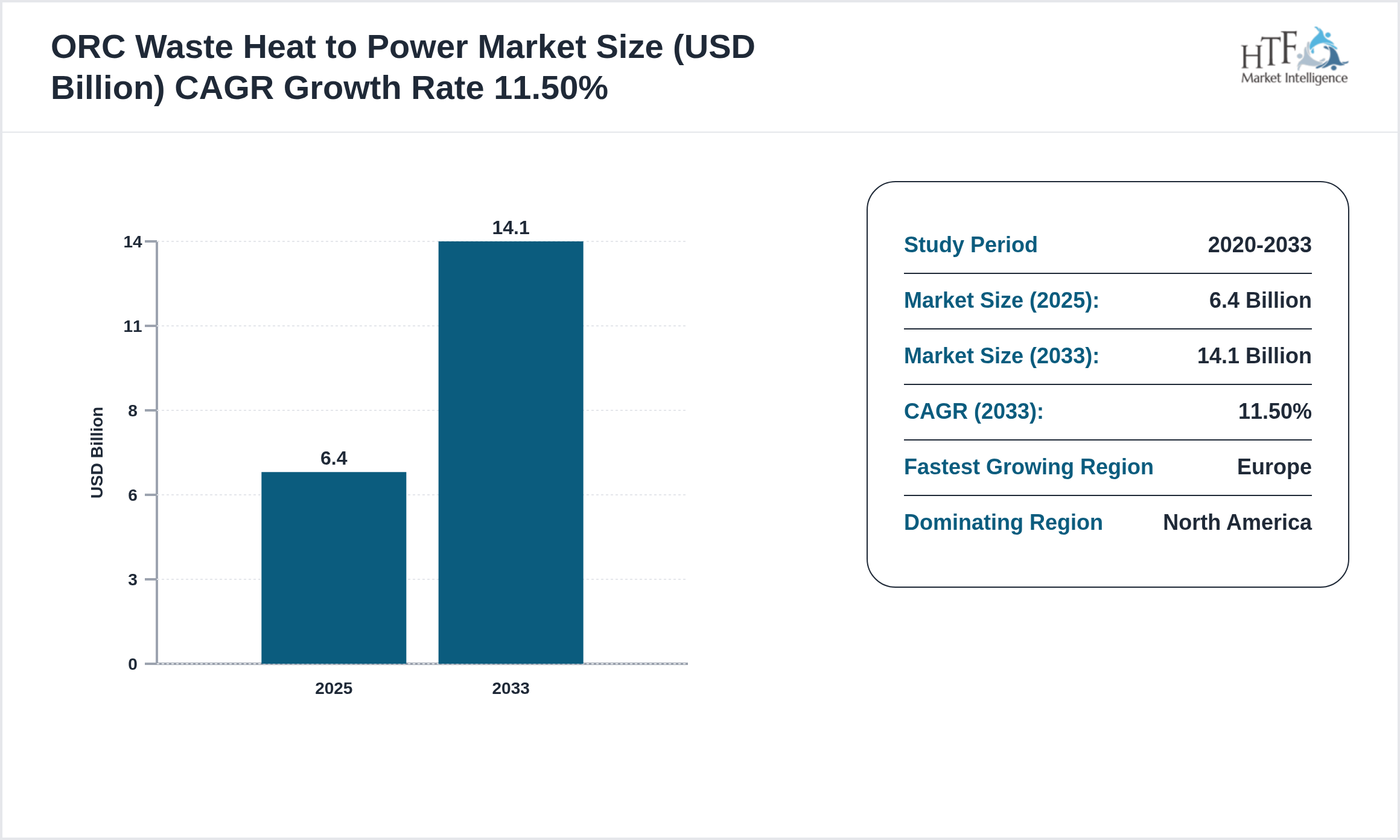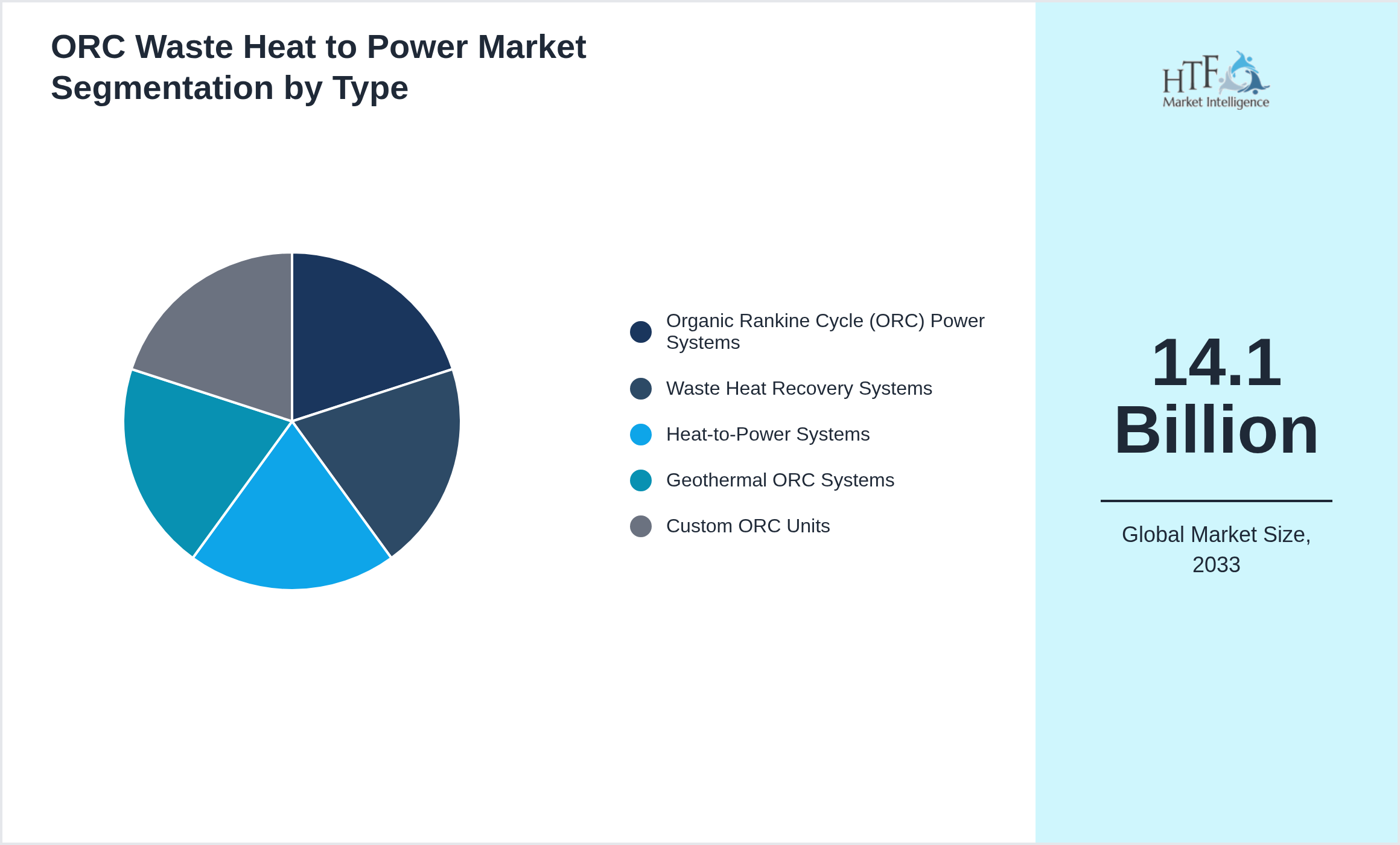ORC Waste Heat to Power Market Research Report
Global ORC Waste Heat to Power Market - Global Outlook 2020-2033
Global ORC Waste Heat to Power Market is segmented by Application (Industrial Manufacturing, Waste-to-Energy Plants, Oil & Gas, Automotive, Utilities), Type (Organic Rankine Cycle (ORC) Power Systems_Waste Heat Recovery Systems_Heat-to-Power Systems_Geothermal ORC Systems_Custom ORC Units), and Geography (North America, LATAM, West Europe, Central & Eastern Europe, Northern Europe, Southern Europe, East Asia, Southeast Asia, South Asia, Central Asia, Oceania, MEA)
Pricing
Industry Overview
The ORC (Organic Rankine Cycle) waste heat to power market involves systems that convert waste heat into electricity, contributing to energy efficiency in industries. ORC systems use organic fluids to recover low-grade waste heat, making them ideal for use in sectors like manufacturing, power generation, and automotive. The market is growing as industries seek energy-efficient and sustainable solutions.

Key Highlights of the ORC Waste Heat to Power
• The ORC Waste Heat to Power is growing at a CAGR of 11.50% during the forecasted period of 2025 to 2033
• Year on Year growth for the market is N/A
• North America dominated the market share of 6.4 Billion % in 2025
• Based on type, the market is bifurcated into Organic Rankine Cycle (ORC) Power Systems, Waste Heat Recovery Systems, Heat-to-Power Systems, Geothermal ORC Systems, Custom ORC Units segment dominated the market share during the forecasted period
• Based on application the market is segmented into Application Industrial Manufacturing, Waste-to-Energy Plants, Oil & Gas, Automotive, Utilities is the fastest-growing segment
• Global Import Export in terms of K Tons, K Units, and Metric Tons will be provided if Applicable based on industry best practice
Dynamics Overview
The market dynamics are influenced by a complex interplay of factors that drive and shape industry behavior. Key elements include supply and demand dynamics, were shifts in consumer preferences or production capabilities impact pricing and market stability. Competitive forces play a crucial role, with companies adjusting their strategies based on competitor actions, pricing, and innovation. Economic conditions like inflation rates, currency fluctuations, and overall economic growth also affect market performance and consumer purchasing power.
Additionally, technological advancements introduce new products and services, disrupting existing market structures and creating growth opportunities. Regulatory changes and policies can alter market dynamics by influencing operational practices and market entry. Understanding these market dynamics requires continuous monitoring and analysis to anticipate trends, identify opportunities, and develop strategies that align with evolving market conditions. Effective management of these dynamics is essential for maintaining competitive advantage and achieving business success.
Influencing Trend:
- • Growth in adoption of waste heat recovery systems in industrial applications
- • increasing use of ORC technology in power generation
- • rise in demand for distributed energy systems
- • growing need for energy-efficient systems in heavy industries
- • expansion of ORC applications in waste-to-energy.
- • Growing industrial waste heat generation
- • increasing adoption of renewable energy systems
- • government incentives for green technologies
- • rising demand for energy efficiency in industries
- • increasing focus on sustainability and circular economy.
- • High capital costs
- • complexity in system integration
- • reliance on industrial heat sources
- • maintenance challenges in large-scale applications
- • dependency on regulatory incentives.
- • Expansion into emerging markets with growing industrial sectors
- • increased adoption in waste-to-energy applications
- • rise in ORC system use in low-temperature heat recovery
- • growth in demand for decentralized power systems
- • development of compact and cost-efficient ORC units.
Import and Export Data
The data is collected, imported, and exported through a comprehensive approach that ensures accuracy and depth. We source information from government databases, which provide official trade statistics and customs data, as well as industry reports and trade journals for detailed market insights. Company filings and financial disclosures also contribute valuable data on import and export activities. To aggregate and normalize this data to maintain consistency and accuracy. To ensure reliability, and cross-verify information across multiple sources and analyze trends to understand market dynamics. The key findings are compiled into detailed reports that offer insights into trade volumes, key markets, and emerging trends, accompanied by actionable recommendations. This thorough process allows to deliver of precise and valuable trade data that supports strategic decision-making for the clients.
Key Players
Several key players in the ORC Waste Heat to Power market are strategically focusing on expanding their operations in developing regions to capture a larger market share, particularly as the year-on-year growth rate for the market stands at N/A. The companies featured in this profile were selected based on insights from primary experts, evaluating their market penetration, product offerings, and geographical reach. By targeting emerging markets, these companies aim to leverage new opportunities, enhance their competitive advantage, and drive revenue growth. This approach not only aligns with their overall business objectives but also positions them to respond effectively to the evolving demands of consumers in these regions.
Regional Insight
The Europe is the fastest-growing region, fuelled by a rapidly increasing population and expanding economic sectors. Factors such as urbanization, improved infrastructure, and government support for industrial development are key drivers. Additionally, the region's young workforce and rising consumer demand are accelerating growth. In contrast, North America remains the dominant region, leading the market with well-established industries, technological advancements, and a strong global foothold.
- North America
- LATAM
- West Europe
- Central & Eastern Europe
- Northern Europe
- Southern Europe
- East Asia
- Southeast Asia
- South Asia
- Central Asia
- Oceania
- MEA
Market Segmentation Overview
• Type segmentation categorizes products by their specific variants, helping businesses identify demand drivers and innovate effectively.
• Application Segmentation: Divides the market based on product usage across industries, enabling targeted marketing and growth identification.
• Geographic Segmentation: Segments the market by location, allowing for tailored strategies based on regional preferences and economic factors.
• Customer Segmentation: Focuses on demographics like age, gender, and income, enabling personalized marketing and improved customer targeting.
• Distribution Channel Segmentation: categorizes by how products reach customers, optimizing supply chain and sales strategies.
Market Segmentation
Segmentation by Type
- • Organic Rankine Cycle (ORC) Power Systems
- • Waste Heat Recovery Systems
- • Heat-to-Power Systems
- • Geothermal ORC Systems
- • Custom ORC Units

Segmentation by Application
- • Industrial Manufacturing
- • Waste-to-Energy Plants
- • Oil & Gas
- • Automotive
- • Utilities
![ORC Waste Heat to Power Market trend by end use applications [Industrial Manufacturing, Waste-to-Energy Plants, Oil & Gas, Automotive, Utilities]](https://htf-insight.s3.us-east-1.amazonaws.com/generated-charts/chart-pie-and-donut-chart-application-4369488-orc-waste-heat-to-power-market-1760051686491-1760051691317-f7fc92e61dd3c882.png)
This report also splits the market by players:
{PLAYER_LIST}
{COMPANY_DONUGHT_GRAPH}
Consumer Behavior Analysis
conduct consumer behavior analysis by examining the factors that influence purchasing decisions. The data starts by collecting data from surveys, focus groups, social media, and transactional records to understand consumer preferences and buying patterns. Then segment consumers based on behaviors such as purchase frequency and brand loyalty, allowing us to tailor strategies for different groups.
The psychographic analysis delves into consumers' attitudes, values, and lifestyles to gain deeper insights into their motivations. Also, tracks emerging trends to anticipate shifts in consumer behavior and uses predictive modeling to forecast future preferences. This comprehensive approach enables to provide actionable insights that help businesses better understand their customers, optimize marketing efforts, and enhance product development.
Market Entropy
- • May 2024 – Ormat Technologies and GE introduced new ORC (Organic Rankine Cycle) waste heat to power systems
- • April
- • Patents focus on innovations in ORC system designs
- • Investment in the ORC waste heat to power market is increasing as industries seek to improve energy efficiency and reduce costs. Companies are focusing on developing ORC systems that integrate seamlessly with existing industrial processes.
Research Methodology
The research delivers comprehensive market insights that combine both secondary and primary methodologies. The secondary research involves rigorous analysis of existing data sources, such as industry reports, market databases, and competitive landscapes, to provide a robust foundation of market knowledge. This is complemented by our primary research services, where we gather firsthand data through surveys, interviews, and focus groups tailored specifically to your business needs. Integrating these approaches, offers a thorough understanding of market trends, consumer behavior, and competitive dynamics, enabling you to make well-informed strategic decisions.
Market Highlights
Report Features
|
Details
|
Base Year
|
2025
|
Based Year Market Size
|
6.4 Billion
|
Historical Period
|
2020
|
CAGR (2025to FORECAST_YEAR})
|
11.50%
|
Forecast Period
|
2033
|
Forecasted Period Market Size (FORECAST_YEAR})
|
14.1 Billion
|
Scope of the Report
|
Organic Rankine Cycle (ORC) Power Systems, Waste Heat Recovery Systems, Heat-to-Power Systems, Geothermal ORC Systems, Custom ORC Units, Industrial Manufacturing, Waste-to-Energy Plants, Oil & Gas, Automotive, Utilities, Sales Channel
|
Regions Covered
|
North America, LATAM, West Europe, Central & Eastern Europe, Northern Europe, Southern Europe, East Asia, Southeast Asia, South Asia, Central Asia, Oceania, MEA
|
Companies Covered
|
Ormat Technologies (USA), Turboden (Italy), ElectraTherm (USA), Siemens (Germany), Mitsubishi Heavy Industries (Japan), ABB (Switzerland), General Electric (USA), MAN Diesel & Turbo (Germany), KBB (Germany), ENOGIA (France), Wärtsilä (Finland), Alfa Laval (Sweden), Astom (France), Carnot (USA), Exergy (Italy), Binary Energy Systems (USA), Doosan Heavy Industries & Construction (South Korea), Sulzer Ltd (Switzerland), BYD (China), JFE Engineering Corporation (Japan)
|
Customization Scope
|
15% Free Customization (For EG)
|
Delivery Format
|
PDF and Excel through Email
|
ORC Waste Heat to Power - Table of Contents
Chapter 1: Market Preface
Chapter 2: Strategic Overview
Chapter 3: Global ORC Waste Heat to Power Market Business Environment & Changing Dynamics
Chapter 4: Global ORC Waste Heat to Power Industry Factors Assessment
Chapter 5: ORC Waste Heat to Power : Competition Benchmarking & Performance Evaluation
Chapter 6: Global ORC Waste Heat to Power Market: Company Profiles
Chapter 7: Global ORC Waste Heat to Power by Type & Application (2020-2033)
Chapter 8: North America ORC Waste Heat to Power Market Breakdown by Country, Type & Application
Chapter 9: Europe ORC Waste Heat to Power Market Breakdown by Country, Type & Application
Chapter 10: Asia Pacific ORC Waste Heat to Power Market Breakdown by Country, Type & Application
Chapter 11: Latin America ORC Waste Heat to Power Market Breakdown by Country, Type & Application
Chapter 12: Middle East & Africa ORC Waste Heat to Power Market Breakdown by Country, Type & Application
Chapter 13: Research Finding and Conclusion
Frequently Asked Questions (FAQ):
The Compact Track Loaders market is projected to grow at a CAGR of 6.8% from 2025 to 2030, driven by increasing demand in construction and agricultural sectors.
North America currently leads the market with approximately 45% market share, followed by Europe at 28% and Asia-Pacific at 22%. The remaining regions account for 5% of the global market.
Key growth drivers include increasing construction activities, rising demand for versatile equipment in agriculture, technological advancements in track loader design, and growing preference for compact equipment in urban construction projects.
